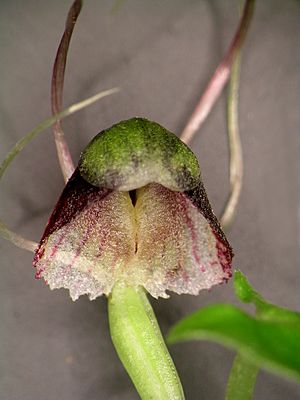Corybas vitreus facts for kids
Quick facts for kids Corybas vitreus |
|
|---|---|
 |
|
| MA I378109 TePapa | |
| Scientific classification |
Corybas vitreus is a special type of orchid that grows only in New Zealand. It was first officially described in 2016 by a scientist named Carlos Adolfo Lehnebach.
What is Corybas vitreus?
This orchid is a seasonal plant, meaning it grows at certain times of the year. It lives on the ground and has just one heart-shaped leaf with smooth edges. Each plant also produces a single flower.
How to Spot It
The flowers of Corybas vitreus are quite unique. Their middle part is mostly see-through, which is why it's called "vitreus" (meaning "glassy"). When it's flowering, the plant stands about 14 to 30 millimeters tall.
It looks a lot like another orchid called C. walliae. However, Corybas vitreus has a see-through lower petal (called the labellum) with a dark maroon or purple band along its side. It's also different from C. trilobus because its flower is broadly oval-shaped.
You can usually see this orchid flowering from September to October. Its fruits then appear from November to early January.
Where Does It Grow?
Corybas vitreus is found only in New Zealand. You can discover it on both the North Island (in the southern parts) and the South Island. It likes to grow in forests, especially those with beech trees or Kunzea plants. You'll often find it nestled in the fallen leaves on the forest floor, at heights ranging from 600 to 1300 meters above sea level.
Is It Endangered?
Good news! Corybas vitreus is currently considered "Not Threatened." This means there are enough of these orchids in the wild, and they are not at risk of disappearing.

